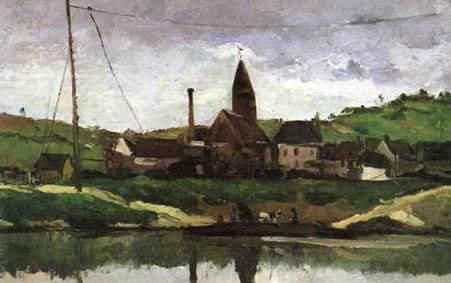 Paul Cézanne Le bac à Bonnières (summer 1866) |
|---|
Paul Cézanne's Railway motifs : The Ferry at Bonnières (summer 1866)
Tomoki AKIMARU(Art Historian)
Key Words: modernity, railway, painting and litterature, Impressionnism and Naturalism, Cézanne and Zola, The Ferry at Bonnières【RESUME】
The steam railway is one of the most typical subjects of the “modernité (modernity).” This subject has been especially related to the Impressionism. For example, it is famous that Emile Zola praised the railway paintings of Claude Monet at the third Impressionist exhibition in 1877.
However, about Paul Cézanne, who was an important member of the Impressionism and actually participated in the exhibition, this subject has not been attached to importance. Based on various proofs by the painting, the document, and the fieldwork, this paper proves many overlooked railway paintings of Cézanne, chiefly in relating to his best friend Zola.
Certainly, from the letter to Zola and other proofs, it is clear that Cézanne was usually using the steam railway in Paris, Bonnières, Aix-en-Provence, Gardanne, Estaque, Medan, Pontoise, and so on. Moreover, in these areas except Paris, Cézanne drew many railway subjects such as a station, a utility pole and electric wires, railway cuttings, signals, rails, railway bridges, and trains.
The most important work is Le bac à Bonnières (summer 1866) in which Cézanne painted a utility pole and electric wires of the station Bonnières, because it is the most earliest railway painting in the Impressionism.
Interestingly, Zola, who spent the summer vacation with Cézanne at Bonnières in 1866 and became the owner of this work, was using three times the word “chemin de fer et télégraphe électrique” in Mes Haine (1866). Further, Zola insisted that the reflection of the science spirit that created them was Naturalism that described the real world in literature and also encouraged to represent the real world in painting. Therefore, Le bac à Bonnières can be understood as a pledge of friendship between Cézanne and Zola that wanted to make the “railway and electric telegraph” as the real world an artistic subject.
Finally, I want to point out the importance of Paul Cézanne’s two railway motifs: “the contrast between premodern and modern” in the subject motif and “the transformation of visual perception induced by steam railway” in the formation motif.
Les motifs du chmin de fer chez Paul Cézanne : Le bac à Bonnières (été 1866)
Tomoki AKIMARU(historien de l'art)
Mots-clés: modernité, chemin de fer, peinture et litterature, Impressionnisme et Naturalisme, Cézanne et Zola, Le bac à Bonnières【RESUME】
Le chemin de fer est un des sujets les plus typiques de la « modernité ». Ce sujet a surtout été en rapport avec l’Impressionnisme. Par exemple, il est connu qu’Émile Zola a loué les tableaux ferroviaires de Claude Monet lors de la troisième exposition impressionniste en 1877.
Cependant, Paul Cézanne, qui était un membre important de l’Impressionnisme et qui a réellement participé à l’exposition, n’a pas attaché d’importance à ce sujet. Sur la base de plusieurs preuves par la peinture, le document, et la recherche, ce papier prouve beaucoup de tableaux ferroviaires négligés de Cézanne, principalement dans concernant son meilleur ami Zola.
Certainement, il est clair dans la lettre à Zola et dans les autres preuves que Cézanne utilisait habituellement les chemins de fer à Paris, Bonnières, Aix-en-Provence, Gardanne, Estaque, Medan, Pontoise etc. De plus, dans ces régions, Cézanne a peint beaucoup de sujets ferroviaires tels qu’une gare, une perche utilitaire et des fils électriques, des copeaux ferroviaires, des signaux, des rails, des ponts ferroviaires et des trains.
Le tableau le plus important est Le bac à Bonnières (été 1866) dans lequel Cézanne a peint une perche utilitaire et les fils électriques de la gare de Bonnières, parce que c’est le premier tableau ferroviaire de l’Impressionnisme.
De façon intéressante, Zola, qui a passé les vacances d’été avec Cézanne à Bonnières en 1866 et est devenu propriétaire de ce tableau, utilisait trois fois le mot « chemin de fer et télégraphe électrique » dans Mes Haine (1866). Plus loin, Zola a insisté sur le fait que la réflexion de l’esprit de la science qui les a créés était du Naturalisme qui décrivait le monde réel dans la littérature et a aussi encouragé à représenter le monde réel dans la peinture. Par conséquent, Le bac à Bonnières peut être compris comme une promesse d’amitié entre Cézanne et Zola qui voulaient faire du « chemin de fer et du télégraphe électrique » du monde reél un sujet artistique.
Finalement, je veux signaler l’importance des deux motifs du chmin de fer chez Paul Cézanne: « le conctrast entre prémoderne et moderne » dans le motif de le sujet et « la transformation de perception visuelle induite par le chemin de fer » dans le motif de la formation.
ポール・セザンヌの鉄道主題――《ボニエールの船着場》(1866年夏)を中心に
秋丸 知貴(美術史家)
キーワード:近代性、鉄道、絵画と文学、印象派と自然主義、セザンヌとゾラ、《ボニエールの船着場》【要約】
蒸気鉄道は、「近代性」の最も代表的な画題の一つである。従来、この画題は、特に印象派に関連付けられてきた。例えば、1877年の第3回印象派展における、クロード・モネの鉄道絵画に対するエミール・ゾラの激賞が有名である。
しかし、印象派の重要な一員であり、同展にも出品していた、ポール・セザンヌについては、なぜかこれまで鉄道画題が重要視されることはなかった。そこで本稿は、作品・文献・現地調査による様々な証拠に基づき、特に親友ゾラとの関係において、セザンヌに見過ごされていた鉄道絵画が多数実在することを指摘する。
事実、ゾラ宛の書簡等の証拠から、セザンヌは蒸気鉄道を、パリ、ボニエール、エクス・アン・プロヴァンス、ガルダンヌ、エスタック、メダン、ポントワーズ等で常用していたと特定できる。そして彼は、実際に上記の諸地域で、鉄道駅、電柱と電線、信号機、切通し、線路、鉄道橋、汽車等、鉄道画題を数多く描いている。
最も注目すべきは、ボニエール駅の電柱と電線が描き込まれた、《ボニエールの船着場》(1866年夏)である。興味深いことに、その年の夏休暇をボニエールでセザンヌと共に過ごし、後にこの作品の所有者となったゾラは、『我が憎悪』(1866年)で、「鉄道と電信」に三度言及している。またゾラは、その鉄道と電信を創造した科学精神の反映が、同時代を描写する自らの自然主義文学であると主張し、さらに美術でも同時代を描出することを激励している。従って、《ボニエールの船着場》は、「鉄道と電信」という同時代を逸早く芸術的に画題化しようとする、セザンヌとゾラの友情の証と理解できる。
最終的に、本稿はポール・セザンヌの二つの鉄道主題の重要性を指摘したい。つまり、画題主題における「前近代と近代の対比」と、造形主題における「蒸気鉄道による視覚の変容」である。